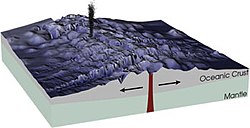Ocean floor spreading
Seafloor spreading (engl. Seafloor spreading ) is the slow lateral deviation ( spreading ) of the ocean floor ( seafloor ) at divergent plate boundaries as part of the process of plate tectonics and thus the mantle .
Basics and terms
The outer rigid shell of the earth, the lithosphere , consists of plates, sometimes millions of square kilometers in area, which “float” on the softer asthenosphere and move relative to one another. Some of the directly adjacent plates move away from each other (plate divergence). The interface between two such plates is typically in the middle of the ocean and is called the spreading zone , in a geometric context also called the spreading axis . The plate boundaries there are characterized by thin, newly formed oceanic crust that is located above a shallow magma chamber . The expansion zone with the plate edges, which are still warm, rises due to buoyancy ( isostasy ) to form an underwater mountain range. These so-called mid - ocean ridges form a global network tens of thousands of kilometers long with diverse volcanic activity .
The magma melts under the expansion zone by relieving pressure from the hot rock of the earth's mantle . The melt collects in the magma chamber below the expansion zone. From there it rises in regular thrusts towards the seabed and forms a layer of basaltic pillow lava on the surface . That part of the lava that does not reach the sea floor remains in the centimeter-wide crevices that were created by the spreading, where it cools down and forms the middle layer of the fresh earth's crust. The lower layer is made of material that crystallizes more or less continuously at the edges of the magma chamber. The corresponding deep rock is called gabbro .
The spread rate is the difference * of the drift speeds of the two plates across the spread axis. For example, the Atlantic Ocean widens an average of 2.5 cm per year * and its oldest oceanic crust, near the continental margins, is around 130 million years old. The world's highest spreading rate is 14.5 cm per year on the south- east Pacific ridge .
causes
The most important driving force behind the spreading is the immersion of the oceanic lithosphere into the deeper earth's mantle ( subduction ) after it has slowly moved away from the spreading zone (often over tens of millions of years), has cooled and its density has increased. In the earth's mantle, the density of the submerged crust increases due to the transformation of basalt into eclogite to such an extent that a continuous pulling effect - called slab pull - is created. Another drive is assumed to be the own weight of the bulging, young oceanic crust of the mid-ocean ridge, which generates a downhill force directed away from the expansion zone - called ridge push - which also drives the plates apart. The friction of the convection currents at the interface between the asthenosphere and the lithosphere is considered to be of little importance for the plate movements .
Emergence
Oceanic spreading zones probably begin in extensive continental rift zones. The Great African Rift Valley , which in sections ( Red Sea , Gulf of Aden ) has already developed into oceanic spreading zones, is considered a prime example of such a rift system.
Side branches of the rift system from which the central Atlantic emerged are still preserved on the east coast of North America in the form of backfilled sedimentary basins running parallel to the coast with deposits from the Upper Triassic and Jurassic (see Newark supergroup ).
Ocean floor spreading and paleomagnetics

Upon cooling of the lava is contained therein align magnetic mineral particulate (mainly magnetite ) according to the circumstances at the time of the earth magnetic field from. As a result, the rock is weakly but permanently magnetized (see remanence ). However, the earth's magnetic field is not stable in geological periods and changes its polarity at irregular intervals . In conjunction with the ocean floor spreading, the polarity reversals of the earth's magnetic field result in symmetrical patterns of strips of similarly magnetized oceanic crust, which run parallel to the spreading axes.
By radiometric dating of the oceanic crustal rocks, each of these strips can be assigned an absolute (numerical) age. The further a certain rock strip is from the spread axis, the older it is and similarly magnetized rock strips that are the same distance from the spread axis are demonstrably the same age. These findings were systematically obtained from the beginning of the 1960s with the help of research vessels , which helped the hypothesis of continental drift to break through. The connection between magnetic polarity and age of a rock subsequently became the basis of a whole sub-area of stratigraphy , magnetostratigraphy .
Remarks
- * Since both plates move away from each other, the speed of one plate is negative in relation to that of the other plate, hence the definition of the spreading rate via the difference in the plate speeds . For the Mid-Atlantic Ridge, this means that the Eurasian and African plates move at 1.25 cm / a and the North American and South American plates at -1.25 cm / a (of course, the other way around from the point of view of the two American plates).
literature
- Wolfgang Frisch, Martin Meschede: Plate tectonics and mountain formation. Scientific book company / Primus-Verlag, Darmstadt, 5th edition 2013
Individual evidence
- ^ Charles DeMets, Richard G. Gordon, Donald F. Argus: Geologically current plate motions. Geophysical Journal International. Vol. 181, No. 1, pp. 1–80, doi: 10.1111 / j.1365-246X.2009.04491.x ( Open Access ), pp. 52 ff.

